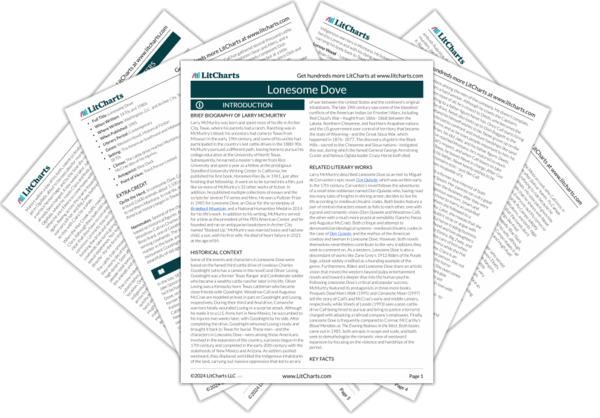Welcome to the LitCharts study guide on Larry McMurtry's Lonesome Dove. Created by the original team behind SparkNotes, LitCharts are the world's best literature guides.
Lonesome Dove: Introduction
Lonesome Dove: Plot Summary
Lonesome Dove: Detailed Summary & Analysis
Lonesome Dove: Themes
Lonesome Dove: Quotes
Lonesome Dove: Characters
Lonesome Dove: Terms
Lonesome Dove: Symbols
Lonesome Dove: Theme Wheel
Brief Biography of Larry McMurtry

Historical Context of Lonesome Dove
Other Books Related to Lonesome Dove
- Full Title: Lonesome Dove
- When Written: 1970s and 1980s
- Where Written: Washington, D.C. and Archer City, Texas
- When Published: 1985
- Literary Period: Contemporary
- Genre: Western Novel, Historical Fiction
- Setting: The American Southwest and Midwest in the late 1870s
- Climax: The cattle drive reaches Montana, and Augustus McCrae dies of his injuries.
- Antagonist: Blue Duck
- Point of View: Third Person Limited
Extra Credit for Lonesome Dove
Quite the Herd. In Lonesome Dove, Call and McCrae drive around 2,600 animals about 1,500 miles from southern Texas to northern Montana. In real life, the longest cattle drive in American history began in Texas but ended in New York City.
Namesakes. Several of the characters in Lonesome Dove are based on historical figures: Augustus McCrae on Oliver Loving, Woodrow Call on Charles Goodnight, and Joshua Deets on Bose Ikard, one of Goodnight’s most trusted and longest-serving cowhands. The sentences Call carves onto Deet’s grave marker in the book are taken almost verbatim from the monument Goodnight erected for Ikard—although Ikard died peacefully of old age.







